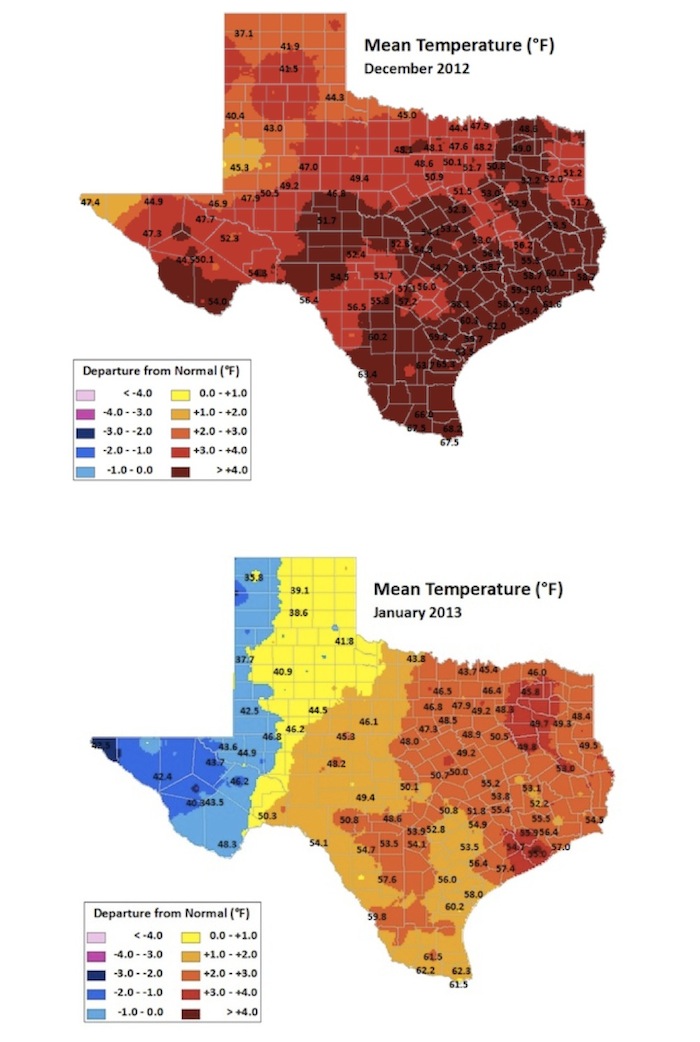A warming global climate isn’t just about hotter summers. Milder winters are also a factor.
This past December and January – the first two of the three months of the 2012-13 winter, as climate scientists define it – were warmer than usual in Texas.
“Texas was much warmer and drier than usual in December,” reported the Office of the State Climatologist at Texas A&M University. “Temperatures ranged from 2 to 9 degrees Fahrenheit above normal with the largest anomalies being centered along the Gulf Coast and then decreasing towards the north and west.”
For January, state climatologist John Nielsen-Gammon’s office hasn’t posted that same kind of narrative assessment, but the statistics on his website tell another story of above-average temperatures – in 17 of 18 listed cities (all but El Paso). An accompanying map similarly shows warmer-than-normal conditions across all but the westernmost part of the state.

December 2012 temperatures were warmer than normal across all of Texas and readings in January 2013 were warmer (though not by as much) in most of the state, as shown on these maps from the Office of the State Climatologist at Texas A&M University.
As TCN Journal noted last month, Nielsen-Gammon explained on his blog that a particularly scorching season such as Texas’ record-hot 2011 summer isn’t necessarily enough to claim the title for a record-hot year – 2012, with a less-hot summer, ended up tied with 1921 as Texas’ warmest year on record, edging the 2011 year-long average:
Everyone remembers the record-setting heat of the summer of 2011. Harder to remember is that January, February, and December of 2011 were all cooler than normal. [The previous record-setting year of] 1921 had a near-normal summer, but the cooler half of the year was consistently warmer than normal. In 2012, the warmth was spread out almost uniformly. Eleven of twelve months recorded above-normal temperature, with October being the sole exception.
These temperatures are also part of a long-term pattern, in this case warming by almost 1.5 F since the 1970s.
Another perspective on the post-1970 trend across the 48 states was offered this week in a report [PDF] by an independent research and journalism organization, Climate Central, which analyzed average-daily temperatures and overnight-low temperatures for the December- February periods from 1912-2012 and 1970-2012.
From the report summary:
While the U.S. as a whole has seen a warming trend that has raised annual average temperatures by 1.3 degrees F over the past 100 years, warming varies seasonally, and it’s winter that has seen the fastest warming.
An analysis of data from the U.S. Historical Climatology Network of weather stations shows that the coldest states are warming the fastest, and across the country winter warming since 1970 has been more than four-and-a-half times faster per decade than over the past 100 years. Winter nights across the country have warmed about 30 percent faster than nights over the whole year. Some states cooled or failed to join the warming trend over the past 100 years, but since 1970, every state has shown winter-warming.
This interactive graphic produced by Climate Central illustrates the analysts’ finding that Texas’ average December-February temperatures rose by 0.57 degrees F per decade from 1970-2012, more than 10 times the per-decade increase of 0.05 degrees F from 1912-2012. That 60-year warming trend was not statistically significant, the organization noted.
– Bill Dawson
Image credits: December 2012 and January 2013 maps – Office of the State Climatologist; interactive graphic – Climate Central.
